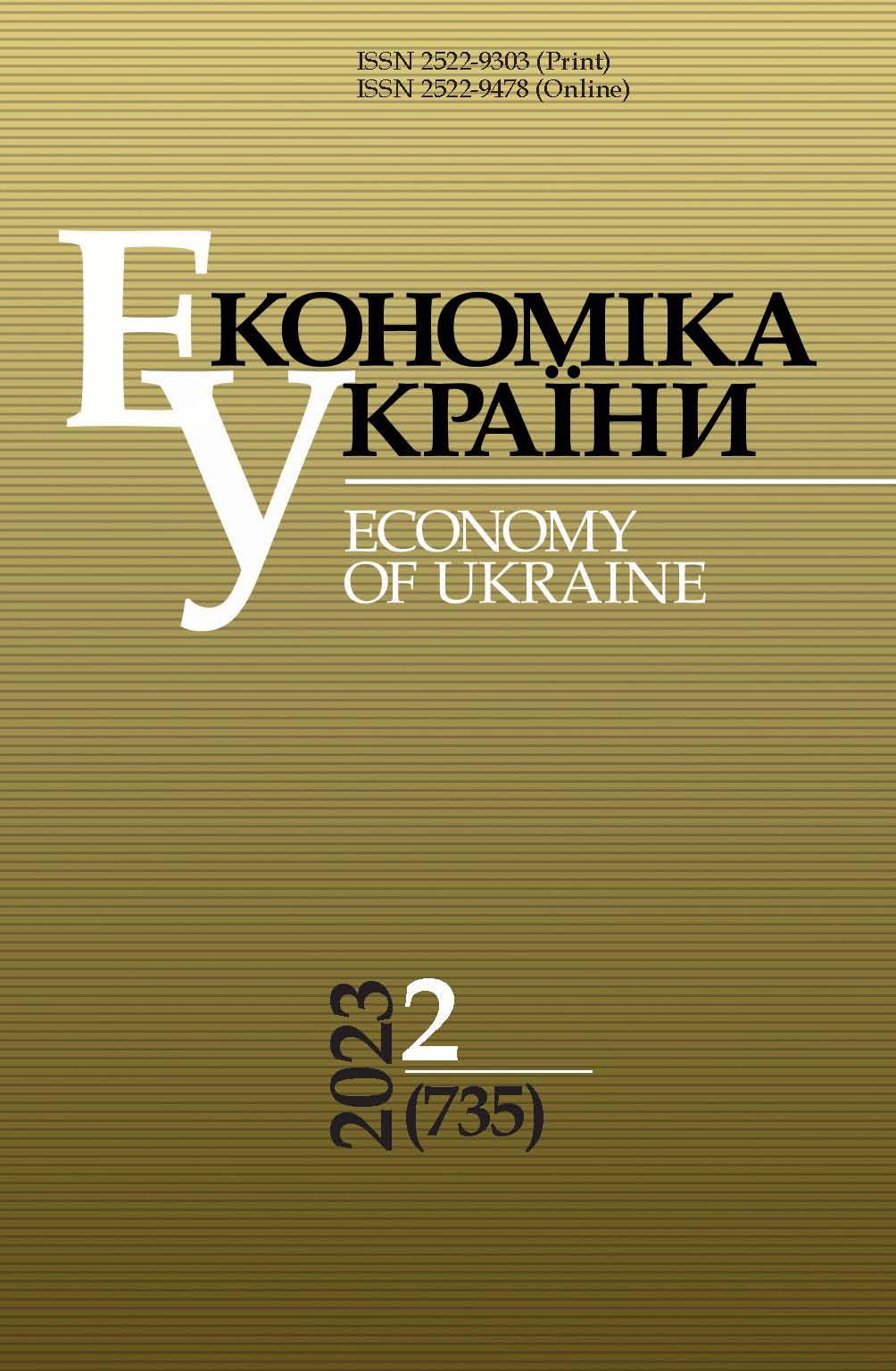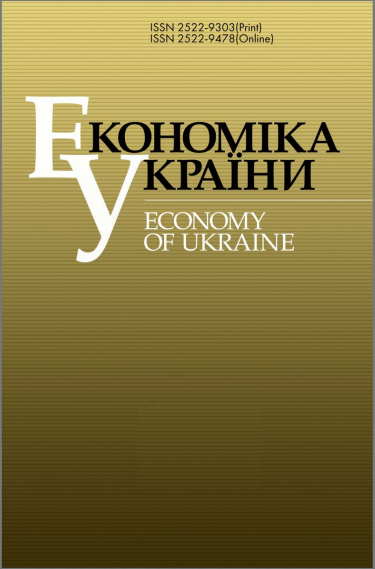ПІДВИЩЕННЯ ТРУДОВОЇ МОБІЛЬНОСТІ ЯК ФАКТОР РОЗВИТКУ ЛЮДСЬКОГО КАПІТАЛУ
DOI:
https://doi.org/10.15407/economyukr.2023.02.073Ключові слова:
людський капітал; трудова мобільність; ринок праці; структурні диспропорціїАнотація
З урахуванням зрослої важливості людського капіталу в сучасному світі та його величезного потенціалу для економічного розвитку, створення сприятливих умов для акумулювання людського капіталу і покращення його характеристик дозволить отримати значущий за розміром і тривалий за часом соціально-економічний ефект. Основоположною передумовою його цілеспрямованого формування в сучасному динамічному світі є трудова мобільність. Феномен трудової мобільності – об’єктивно існуюче явище будь-якого ринку праці; вона відображає рух робочої сили як товару, а її динаміка формує кон’юнктуру ринку. Релокація є суттєвим чинником впливу на сукупну продуктивність праці, використання робочої сили, а отже, на формування і використання людського капіталу. Трудову мобільність, що визначає якісну характеристику робочої сили, її потенційну здатність до зміни функцій у виробництві матеріальних і нематеріальних благ, готовність до професійно-кваліфікаційного зростання, опанування нових професій, здатність адаптуватися в динамічних виробничих умовах, зумовлено перспективою структурної трансформації вітчизняної економіки, змінами регіональної спеціалізації у процесі повоєнної відбудови економіки і сучасними економічними умовами, коли технологічні процеси й вимоги ринку праці до функціональних обов’язків працівників швидко змінюються.
Структурно деформована, диспропорційна, позбавлена власних стабільних рушіїв розвитку, вітчизняна економіка не здатна належним чином реагувати на існуючі ризики і кризові коливання. Накопичені на ринку праці негаразди характеризуються не тільки загрозами, але й серйозними негативними наслідками. Під час воєнних дій і в період повоєнного відновлення заходи державної політики у сфері збереження й використання людського капіталу мають бути максимально ефективними і спрямовуватися на зменшення структурних дисбалансів у сфері зайнятості, забезпечення дієвості «соціальних ліфтів», удосконалення системного пакета законодавчих і соціально-економічних засобів щодо регулювання ринку праці й соціально-трудових відносин.
Посилання
Blyzniuk V.V. Human capital as a factor of economic development (evolution of methodological approaches and modernity). Economics and Forecasting, 2005, No. 2, pp. 67-78 [in Ukrainian].
Bilyk O.M. The main directions of preservation and development of national human capital through labor mobility activation. Ukraine: Aspects of Labor, 2009, No. 1, pp. 43-46 [in Ukrainian].
Lichkovska M.R. Essence and tendencies of forming of labour mobility: national problems. Economy and Society, 2018, No. 18, pp. 667-673. URL: https://economyandsociety.in.ua/journals/18_ukr/93.pdf [in Ukrainian].
Shtunder I. Labor mobility as a means to ensure effective employment. Scientific Notes of «KROK» University, 2013, Vol. 34, pp. 115-122 [in Ukrainian].
Kovalyov O.S. To the question of labor mobility of workers in Ukraine in today's conditions. In: The European choice of Ukraine, the development of science and national security in the realities of large-scale military aggression and global challenges of the 21st century. Vol. 1. Odesa, 2022, pp. 584-587 [in Ukrainian].
Pristupa M. Transformation of labor relationships under the globalization influence: new problems of social policy. SOCIOPROSTIR, 2020, No. 9, pp. 23-30 [in Ukrainian].
Hall D.T. Protean careers of the 21st century. Academy of Management Perspectives, 1996, No. 10, pp. 8-16.
Sullivan S.E. The changing nature of careers: A review and research agenda. Journal of Management, 1999, No. 25, pp. 457-484.
Tikhonova L., Krasinets E. Labour Migration and Migration Policy of the Republic of Belarus within the Framework of Integration into the Eurasian Economic Union. Journal of International Law and International Relations, 2015, No. 2, pp. 67-71 [in Russian].
Courhene T.J. Interprovincial Migration and Economic Adjustment. The Canadian Journal of Economics, 2002, Vol. 3, No. 4, pp. 289-341.
Nesterova A.A. Labor mobility of the population in the context of regional integration. Minsk, 2020 [in Russian].
Tilikina N.V. The factors of the labour force space mobility and their classification. Demography and social economy, 2008, No. 2, pp. 163-169 [in Ukrainian].
Littler C.R., Wiesner R., Dunford R. The dynamics of delayering: Changing management structures in three countries. Journal of Management Studies, 2003, No. 40, pp. 225-256.
Arthur M.B., Rousseau D.M. Introduction: The boundaryless career as a new employment principle. In: The boundaryless career: A new employment principle for a new organizational era. M.B. Arthur, D.M. Rousseau (Eds.). New York, Oxford University Press, 1996, pp. 3-20.
Stahl G.K., Gerdin J. Global careers in French and German multinational corporations. Journal of Management Development, 2004, No. 23, pp. 885-902.
White M., Hill S., Mills C., Smeaton D. Managing to change? British workplaces and the future of work. Basingstoke, Palgrave Macmillan, 2004.
Bentein K., Vandenberg R.J., Vandenberghe C., Stinglhamber F. The role of change in the relationship between commitment and turnover: A latent growth modeling approach. Journal of Applied Psychology, 2005, No. 90, pp. 468-482.
Lance C.E., Vandenberg R.J., Self R.M. Latent growth models of individual change: The case of newcomer adjustment. Organizational Behavior and Human Decision Processes, 2000, No. 83, pp. 107-140.
Vandenberg R.J., Self R.M. Assessing newcomers’ changing commitments to the organization during the first 6 months of work. Journal of Applied Psychology, 1993, No. 78, pp. 557-568.
Anderson J.C., Milkovich G.T., Tsui A. A model of intra-organizational mobility. Academy of Management Review, 1981, No. 6, pp. 529-538.
Greenhaus J.H., Callanan G.A., Godshalk V.M. Career management. Orlando, 2000.
Saxenian A. Beyond boundaries: Open labor markets and learning in Silicon Valley. In: The boundaryless career: A new employment principle for a new organizational era. New York, Oxford University Press, 1996, pp. 23-39.
Louis M. Career transitions: Varieties and commonalities. Academy of Management Review, 1980, No. 5, pp. 329-340.
Nicholson N., West M. Managerial job change: Men and women in transition. Cambridge, Cambridge University Press, 1988.
Neal D. The complexity of job mobility among young men. Journal of Labor Economics, 1999, No. 17, pp. 237-261.
Tolbert P.S. Occupations, organizations, and boundaryless careers. New York, Oxford University Press, 1996.
Blyzniuk V., Yatsenko L. Features of labor market development in the conditions of formation of “new economy”. Scientific Bulletin of Poltava University of Economics and Trade. Series "Economic Sciences", 2021, No. 1(102), pp. 74-81 [in Ukrainian].
Sadovnichiy V.A., Akayev A.A., Korotayev A.V., Malkov S.Yu. Modelling and Forecasting World Dynamics. M., 2012 [in Russian].
Semykina M.V., Ishchenko N.A., Rodionova M.O. Motivation of effective employment: problems, trends, strategy selection. Kirovohrad, 2009 [in Ukrainian].
##submission.downloads##
Опубліковано
Як цитувати
Номер
Розділ
Ліцензія
Авторське право (c) 2023 Видавничий дім "Академперіодика" НАН України

Ця робота ліцензується відповідно до Creative Commons Attribution-NonCommercial-NoDerivatives 4.0 International License.



